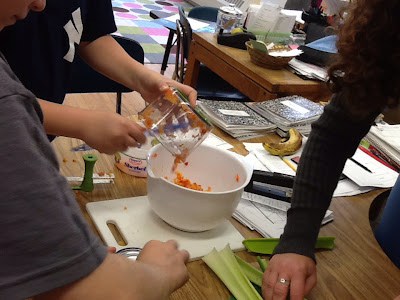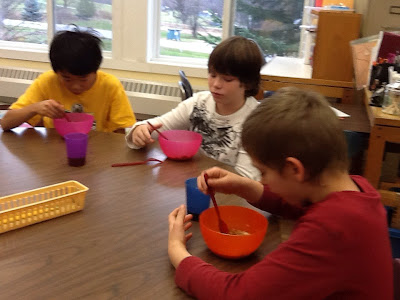We started the morning with spelling and a roux. I heated up equal parts flour and oil and as each spelling group came to the horseshoe-shaped table where I meet with small groups, we examined the roux before turning our attention to new spelling packets. I was a bit skeptical, knowing what happens when any small quantity of a mixture stays on the stove for too long, even at low heat. But although the rest of the ingredients in gumbo can vary, every recipe I read insisted that gumbo starts with a roux, and a roux is flour and oil or butter cooked for at least thirty minutes over low heat. Kids exclaimed that it looked like a gravy, and as it heated (but didn't dry up and stick in the pan, thank goodness!) a fragrant smell filled the room.
Spelling packets got stowed and as snack started, my most enthused cooks joined me to chop up onion, celery and pepper, otherwise known as the trinity of Cajun cooking.
The food chopper is unbelievable. I wish I had gotten video, or at least a better picture, of it in action. Let's just say that the afternoon of making salsa could have taken a fraction of the time.
Another student came over and started mixing the veggies into the roux. Then I brought out the okra. It is such a weird vegetable that I wanted to expose my students to it, even if it was in frozen form. A few kids tried a piece of it as it defrosted and were unfazed. Others waiting to chop some of it, mainly, I think, because they wanted to try out our new knife.
One quieter sixth grade girl came over as I shooed off the kids who had been with me for the entire snack, and happily chopped up most of the bag of okra and then helped me mix it and the vegetable-roux mixture into a pot of boiling water and tomato sauce. Another friend of hers joined us and they added the salt, pepper and other dried seasonings. When we first started snack, they hadn't rush the table and I thought they were more interested in socializing with their friends over snack than they were in cooking. Now I realize they were just waiting for a quieter opportunity to help out. This interests me because clearly these cooking projects are of high interest to the fifth grade boy population in my room, based on how they practically push themselves into the center of things when we start cooking. But this very behavior causes some of the more hesitant kids to hang back until they can see a safe opening for themselves.
Back to the gumbo: it simmered through reading groups and writing. Then during lunch I browned the sausage, added it to the gumbo, and made a pot of rice. Earlier in the week, we read about how rice was used to stretch many Cajun dishes. I opted to use sausage as shellfish was not an option and fresh catfish did not present itself to me at the grocery store and
Tear your eyes away from the amazing looking food and check out the sexy new two burner stove!
In the afternoon after math, I put some Zydeco music on the CD player and once again wished I had captured the hip movements that started almost instantaneously. The music continued to play as I served our three course feast: gumbo, rice, and ridiculously sugary iced tea I had made at home the night before.
I had wondered if the okra would get picked out of the gumbo and discarded; I hadn't spent a lot of time introducing it to the whole class so it was truly a mystery entity. To my surprise, it got gobbled down along with everything else.
In case you were wondering, the dish washing process went much more smoothly. Phew!
This was a day when we cooked while the rest of school was happening. It happened that way out of necessity – there wasn't a time this week when I could schedule a cooking-only session. When we cook this way I worry that I am missing the mark by letting students decide if and how much they will help us out. But a conversation with a student during writing on Wednesday made me rethink things. He is writing a report on how our school is helping students learn about healthy eating habits. He told me that he has learned that it's ok to try new foods and he is more likely to do so than he would have been previously. As I watched the majority of students in my class munch on a okra-laden gumbo, I decided it didn't matter if each student had a hand in the making of the gumbo. It was made in the context of learning about the southeastern states, and it encouraged kids to try new foods in a new combination. That's plenty of learning for me.






No comments:
Post a Comment